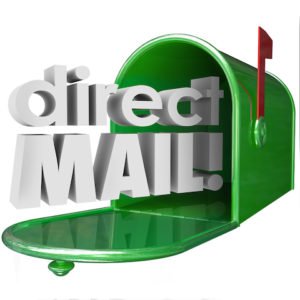As is the case with selling any type of insurance, generating a consistent, high-quality source of qualified leads is paramount to success in selling final expense insurance. Without it, neither a new or experienced agent will have a long-term career in the insurance business.
In this article, based on personal experience, I have detailed what I consider to be the best types of final expense leads, speaking specifically on how each lead works, and my personal judgment of its overall quality. Keep in mind that this testimony is based on 7 years of personal production selling final expense exclusively as of the date of this article, as well as personally training hundreds of agents across the country.
Direct mail leads
Direct mail is one of the most common ways to generate a consistent, high-quality flow of leads. If you’re unfamiliar with the lead generation process, direct mail leads refer to business reply card mailers, where the recipient replies requesting more information. Within several weeks, the agent receives the lead, typically working the lead by either showing up at the house unannounced (a drive-by or door knock), or by calling ahead of time to set up an appointment.
This is the standard approach to doing final expense business. Most major marketing organizations are doing some sort of direct mail lead generation similar to this with some variation depending on what it is the agent wants to accomplish.
However, there are some issues with direct mail as a primary source of generating leads. The biggest concern many agents and agencies have experienced is dwindling response rates. Selling final expense is more popular than ever. More new and experienced agents are entering final expense as other insurance niches become more competitive or government regulated.
More agents selling final expense means more agents dropping direct mail leads. Where 10 to 15 years ago prospects received one or two direct mail leads a month, they are now seeing upwards to 6 to 8 direct mail leads a month. Most only reply when they’re in the window of opportunity to buy, and rarely will our prospects send more than one or two when interested.
Where you used to have a good shot at being the only guy responded to, the odds of that being the case are lower with so many agents doing direct mail leads. Less and less people respond to all these mailers, which has a direct impact on every single final expense agent that utilizes this time-proven lead system.
So what’s the solution to this problem? The most effective solution I have seen is that there are firms offering fixed-price direct mail final expense leads.
The concept is simple. In exchange for doing a high volume of business with a third-party mail house, the marketing organization gets a fixed purchase price on each direct mail lead. The mail house absorbs the risk of a low response rate, and in exchange, the agent has the added benefit of knowing exactly what he’s going to pay for his direct mail leads.
This option is very agent-friendly. Instead of potentially paying $40+ per lead, leads have a guaranteed fixed price that is closer to the $30 mark (as of 2017). Agents don’t have to worry about response rate variation, and it gives agents peace of mind.
Another way agents work around the low response rates dilemma is to utilize leads with less specificity. I refer to these as “vanilla leads.”
Once again, the concept is simple. Eliminating specific verbiage such as “life insurance,” “burial insurance,” or references to costs such as “costs pennies per day,” has shown to drive curiosity in recipients more so than those lead pieces with verbiage specificity, resulting in higher response rates. However, with less specificity comes more confusion. Many respondents will mistakenly believe the lead implies an unheard-of government benefit that will pay for his or her funeral costs without any out-of-pocket expenses.
While many agents complain this type of “vanilla lead” equates to a lower quality lead, many tenured final expense agents don’t care, as their results with vanilla leads are just as good as with more specific leads.
Telemarketing final expense leads
Telemarketing final expense leads are generated domestically or internationally over the phone by a live telemarketer. Unfortunately, my experience with final expense telemarketing leads has been unsatisfactory over the past several years, as government regulations have proven the process of generating leads over the phone more costly and ineffective.
Arguably the most popular method of generating telemarketing leads, known as avatar telemarketing, was made illegal in May 2017. This eliminated one of the most cost-efficient ways to generate decent-quality final expense telemarketing leads.
With avatar leads now illegal, along with robocalling and voicemail leads, the only viable approach to telemarketing for leads is to depend on actual, real-life telemarketers. The results have been, a), an increase the cost to generate telemarketing leads, and b), a reduction in quality, as foreigners generally lack the ability to communicate the finer nuances of American English dialect.
As an agency owner responsible for training and recruiting successful final expense agents, I see no long-term or short-term reason to use telemarketing as a primary source of final expense leads. The higher cost combined with lower quality no longer make telemarketing for leads a viable solution. Acquisition costs and regulatory involvement in telemarketing will only increase in the future, and with more of our prospects opting out of landline phones, means telemarketing leads will become less and less effective.
I advise my agents to buy telemarketed leads only as a filler if response rates are low for their primary lead sources. Beyond that, telemarketed leads have seen their heyday.
Web-based lead generation on the rise
Interest in leveraging the Internet to produce final expense leads is on the rise with higher pricing concerns regarding telemarketing and direct mail lead generation.
What we see final expense lead vendors offering are leads generated either from Facebook or from Google search engine results. Ads are placed in front of people that meet the demographic criteria of what one normally markets to via final expense direct mail and telemarketing lead generation. Specifically, regardless of what platform is used, prospects are directed to fill out and submit a lead form, and agents follow up just like they would with a direct mail lead.
Most of the successful final expense leads on a purchased basis tend to be generated from Facebook. There are several vendors now offering Facebook final expense leads, and agents report a good level of success.
One of the biggest benefits of internet-based lead generation is a faster turnaround time when compared to direct mail lead generation. Whereas direct mail leads take closer to a month to turn around, Facebook lead fulfillment takes between 3 to 5 business days.
The quality of response from internet-based final expense lead generation is similar to that of direct mail, although I would argue that direct mail is superior. Agents have noted that internet leads tend to skew economically better than final expense direct mail leads, and can be a little bit harder to reach over the phone.
Old-fashioned lead generation programs becoming more popular
 Many agents entering the final expense business realize very quickly the importance of self-financing their lead programs. Many of these agents are finding unique ways to generate leads without having to invest money in paid leads.
Many agents entering the final expense business realize very quickly the importance of self-financing their lead programs. Many of these agents are finding unique ways to generate leads without having to invest money in paid leads.
One of the more popular ways to do so is seminar marketing. The agent approaches activity directors in senior housing facilities and asks to put on an educational seminar for residents, discussing the pros and cons of final expense life insurance. After the seminar is completed, the agent conducts final expense presentations with seminar attendees with the goal of closing a handful of them.
The biggest advantage to this marketing approach is that it costs very little. Most of the expense is associated with providing food for the attendees, but there is no other added expense beyond your time invested. Seminar marketing is a great method for agents that are low on capital funds, but love public speaking opportunities to create their own leads.
Summary of final expense leads in 2017
First, if you’re new to final expense, you must focus your lead generation attention primarily on direct mail leads.
Quite frankly, there is no substitute for direct mail leads. As I commonly tell my new agents, virtually all the people that go on carrier conventions source their business from purchased direct mail leads. There isn’t any lead generation method that commands as much results across the board as direct mail lead generation does. So, my recommendation is to not reinvent the wheel. Simply follow the schematics of whatever works. And in the final expense business, direct mail is king, so you might as well go ahead and do it.
Second, do your best to work with an agency that provides fixed-price leads to lock in your cost so you can avoid the pitfalls of diminishing direct mail response rates. While there are some parts of the country where a fixed price on direct mail leads is unnecessary, the added benefit of a fixed-price program is your costs are completely under control and proportional to the number of leads you get.
Lastly, what if you don’t have access to fixed-price leads? Use the “vanilla lead” mentioned earlier. The high response rates typically are good enough to support a lower average price point. Make sure you work with an upline who understands how to work these particular types of leads, as they tend to be more difficult for the less-seasoned agent.
Going into 2018, I see no short- or long-term challenges that alter my opinions regarding direct mail. I see direct mail lead generation as the solitary and most successful form of purchased final expense lead options. Certainly, there is a case for alternative lead generation such as seminar marketing or Facebook leads. But, I don’t think either method holds a candle to what direct mail lead generation has done for many agents across the country as far as transforming their business into a success.
If an agent must use non-direct mail leads, use them only as fill-ins when direct mail response rates are low.
More from David Duford:
- Choosing the right kind of lead for new final expense agents
- Selling final expense: 7 fundamental steps every new final expense agent must follow
- My Top 8 Final Expense Carriers for 2016
• Editor’s Note: This article was submitted by Insurance Forums member David Duford (Screen name: Rearden) of Final Expense Agent Mentor.
• Thoughts or comments? Please chime in on this thread: FE leads in 2017: What’s working now













